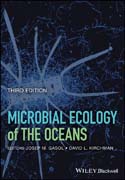
The newly revised and updated third edition of the bestselling book on microbial ecology in the oceans The third edition of Microbial Ecology of the Oceans features new topics, as well as different approaches to subjects dealt with in previous editions. The book starts out with a general introduction to the changes in the field, as well as looking at the prospects for the coming years. Chapters cover ecology, diversity, and function of microbes, and of microbial genes in the ocean. The biology and ecology of some model organisms, and how we can model the whole of the marine microbes, are dealt with, and some of the trophic roles that have changed in the last years are discussed. Finally, the role of microbes in the oceanic P cycle are presented. Microbial Ecology of the Oceans, Third Edition offers chapters on The Evolution of Microbial Ecology of the Ocean; Marine Microbial Diversity as Seen by High Throughput Sequencing; Ecological Significance of Microbial Trophic Mixing in the Oligotrophic Ocean; Metatranscritomics and Metaproteomics; Advances in Microbial Ecology from Model Marine Bacteria; Marine Microbes and Nonliving Organic Matter; Microbial Ecology and Biogeochemistry of Oxygen–Deficient Water Columns; The Ocean s Microscale; Ecological Genomics of Marine Viruses; Microbial Physiological Ecology of The Marine Phosphorus Cycle; Phytoplankton Functional Types; and more. A new and updated edition of a key book in aquatic microbial ecology Includes widely used methodological approaches Fully describes the structure of the microbial ecosystem, discussing in particular the sources of carbon for microbial growth Offers theoretical interpretations of subtropical plankton biogeography Microbial Ecology of the Oceans is an ideal text for advanced undergraduates, beginning graduate students, and colleagues from other fields wishing to learn about microbes and the processes they mediate in marine systems. INDICE: Preface .List of contributors .Chapter 1: Introduction: the evolution of microbial ecology of the ocean. .1.1 A brief history of marine microbial ecology .1.2 An assessment of current marine microbial ecology .1.3 The future of marine microbial ecology .Literature cited .Chapter 2: Marine microbial diversity as seen by high throughput sequencing .2.1 Diversity .2.2 The methods .2.3 The use of sequences as proxies for taxa .2.4 Diversity after HTS .2.5 Conclusion .Chapter 3: Ecological significance of microbial trophic mixing in the oligotrophic ocean: The Atlantic Ocean case studies .3.1 Oligotrophic oceanic gyres the most extensive, microbe–dominated biome on Earth .3.2 Microbial composition of the subtropical gyres .3.3 Prokaryotic photoheterotrophy in gyres the ability to use light energy and to take up organic molecules simultaneously .3.4 Eukaryotic mixotrophy in gyres the ability to use light energy and simultaneously prey on bacterioplankton .3.5 How do photoheterotrophy and mixotrophy affect the co–existence of bacteria and eukaryotes in gyres? .3.6 Knowledge gaps .3.7 Summary .Chapter 4: Metatranscritomics and Metaproteomics: Elucidating Marine Microbial Ecosystem Functions .4.1 Introduction to the era of marine omics and big data .4.2 Overview of the metatranscriptomics approach .4.3 Overview of the metaproteomics approach .4.4 Key considerations in detecting community ecosystem functions .4.5 Importance of cultivation based studies, replication and quantification .4.6 Assessment of pelagic microbial community transcriptomics and proteomics .4.7 Summary points .Chapter 5: Advances in microbial ecology from model marine bacteria: beyond the Escherichia coli paradigm .Abstract and Keywords .5.1 Introduction .5.2 Cultivation Approaches .5.3 Lessons Learned from Ecophysiological Response Experiments with Cultivated Bacteria .5.4 Concluding Remarks .Summary .Acknowledgments .Chapter 6: An inseparable liaison: marine microbes and nonliving organic matter .6.1 An inseparable liaison: marine microbes and nonliving organic matter .6.2 Marine carbon reservoirs .6.3 Biogeochemical cycles and their microbial engines .6.4. Driving forces for turnover kinetics .6.5. Spatial and temporal changes in organic matter and microbial communities .6.6. The challenge for future research: understanding the functional network of marine microbes and organic molecules .References .Chapter 7: Microbial ecology and biogeochemistry of oxygen–deficient water columns .7.1 Introduction .7.2 Current Trends .7.3 Characterizing oxygen deficiency – terms and definitions .7.4 Types of oxygen–deficient aquatic systems .7.5 Physico–chemical profiles as indicators of biogeochemical zones .7.6 General considerations of microbial metabolism in ODWCs .7.7 Biogeochemical cycles in oxygen–deficient systems and major prokaryotes involved .7.8 Microbial food webs in ODWCs .7.9 Summary .7.10 Bibliography .Chapter 8: The ocean s microscale: A microbe s view of the sea .8.1 Introduction .8.2 The microscale physics of the pelagic ocean .8.3 Particles, patches and phycospheres .8.4 Motility and chemotaxis .8.5 Microscale microbial interactions .8.6 Microbial metabolic adaptions to microscale heterogeneity in seawater .8.7 Biogeochemical implications of microscale interactions .8.8 Summary .References .Chapter 9: Ecological Genomics of Marine Viruses .9.1 Introduction .9.2 Genomics of isolated marine viruses .9.3 Investigating viral community diversity in nature .9.4 Marine viral community diversity and structure .9.5 Depth–related patterns emerging from analysis of marine viral metagenomic datasets .9.6 Emerging temporal patterns in marine viral communities .9.7 Annotating the unknown: the need for creative solutions .9.8 Investigation of virus–host interactions in the wild .9.9 Future challenges in marine viral ecology .9.10 Summary .Chapter 10: Microbial physiological ecology of the marine phosphorus cycle .10.1 Introduction .10.2 Methodological Advances and Challenges .10.3 Phosphorus Biogeochemistry .10.4 Phosphorus in The Cell .10.6 Inorganic Phosphorus Utilization .10.7 Organic Phosphorus Utilization .10.8 Phosphorus Stress Responses .10.9 Case Studies in Phosphorus Physiology .10.10 Case Studies with Different Systems .10.11 Summary .Chapter 11: Phytoplankton functional types: a trait perspective .11.1 What are functional types? .11.2 The major functional traits .11.3 Challenges using traits to represent functional types .11.4 Using field data to identify relevant traits and estimate trait values .11.5 Should we model functional types or individual species? .11.6 A way forward .References .Chapter 12: Theoretical Interpretations of Subtropical Plankton Biogeography .12.1 Introduction: Phytoplankton biogeography in the subtropical ocean .12.2 Resource competition, fitness and cell size .12.3 Co–existing size classes: Predation levels the playing field .12.4 Niche Differentiation and Resource Ratio Theory .12.5 Discussion and Outlook .12.6 Summary .12.7 Acknowledgements .12.8 References .Index .
- ISBN: 978-1-119-10718-7
- Editorial: Wiley–Blackwell
- Encuadernacion: Cartoné
- Páginas: 592
- Fecha Publicación: 10/01/2018
- Nº Volúmenes: 1
- Idioma: Inglés
